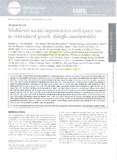| dc.description.abstract | It is increasingly recognized that association patterns of most gregarious animals are nonrandom. However, nonrandom patterns can emerge in any population that exhibits spatial structure, even if individuals associate randomly. In species that lack clearly differentiated social relationships characteristic of socially complex mammals, space use patterns must be considered alongside association patterns in order to establish whether nonrandom association patterns are determined by underlying social structure or are merely an artifact of spatial structure. In this study, we simultaneously consider space use and association patterns for a wild population of reticulated giraffe. We examined whether the giraffe’s flexible fission–fusion association patterns were embedded in higher levels of social organization. We identified multilevel social organization in which individuals were members of social cliques. Cliques were embedded in larger subcommunities, which in turn were embedded in communities. The frequency with which 2 individuals were observed together was positively correlated with the extent to which their home range overlapped, implying an underlying role of shared space use in determining association patterns. However, membership in cliques and subcommunities was relatively unrelated to space use patterns for males. For females, space use played a much larger role in determining multitiered social organization, which is consistent with a matrilineal-based society characterized by female philopatry. Although giraffe social interactions are highly fluid in nature, it is apparent that association patterns in giraffe are not the result of random fission–fusion events but are embedded within a structured social network characterized by multiple levels of organization. | en_US |

